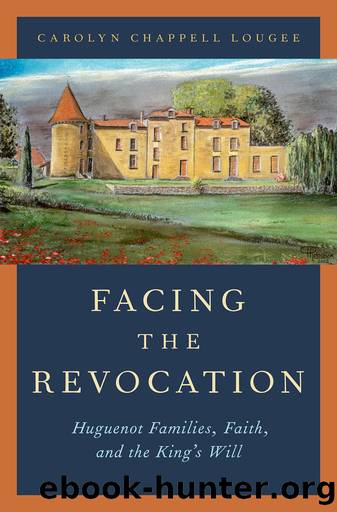Facing the Revocation by Carolyn Chappell Lougee

Author:Carolyn Chappell Lougee
Language: eng
Format: epub
Publisher: Oxford University Press
Published: 2016-03-15T00:00:00+00:00
Whither Berneré?
Once Thérèse died, there were no more Champagné in France. Since all Thérèseâs siblings were fugitives, her properties would be split among her nearest paternal and maternal kin, according to the estatesâ varied provenances. Her fatherâs properties fell to the daughters of Casimir Prévost de Touchimbert and Marie de Robillard. Berneréâstill encumbered by Madelene de Solièreâs long battle to recover her dowry and légitimeâ went in the short term to her motherâs sister, Elisabeth de La Rochefoucauld, who had married Jean-Baptiste Dupuy de La Martinie in 1686.41 But the contest for Berneré would drag on for nearly half a century longer.
In January 1705, Madelene de Solière won an order from the Parlement of Bordeaux prohibiting Elisabeth from cutting timber at Berneré, on the grounds that she could not degrade the value of property on which the Parlement had recognized Madeleneâs legitimate claim. At last, in July 1706, Madelene de Solière gained the final ruling in the long-running case, which annulled the renunciation of inheritance she had signed decades before and in effect placed the parties once again in the situation predating Madeleneâs marriage, with Madelene entitled to 12,000 livres, plus interest, from the holdings of her long-deceased sister, mother of the La Rochefoucauld sisters.42 Madelene de Solière savored her vindication only briefly, for she died the following year.43 Her heir was Susanne de Lestang, daughter of Madeleneâs sister Susanne de Solière.44 Lestang obtained an arrêt in 1709 from the Parlement ordering payment to (the heirs of) Madelene de Solière of the inheritance her mother, Susanne Isle, had never given her: the original 12,000 livres plus 24,000 livres in interest. Elisabeth de La Rochefoucauld, having no other means of paying the swollen inheritance as the court ordered, ceded Berneré to Susanne de Lestang on January 12, 1710.45
In the end, then, Madeleneâs struggles availed herself little and accomplished only the transfer of her parentsâ estate from one set of her nieces to another: from the daughters of her eldest sister, whom parental preference had designated for the larger legacy, to the daughter of her younger sister, who, as third-born, had accepted a minor portion without demur. By disputing the property division that Susanne Isle elected, Madelene contributed to the abandonment of Thérèse by the emigration of Marie de La Rochefoucauld and the rest of the Champagné.
Even then, Berneré knew no closure. Two years after Elisabethâs cession, Berneré formed part of the brideâs dowry when Susanne de Lestang married Benjamin Maichin, Seigneur de Bessé et de Trézence, a cavalry captain.46 But even the Lestang-Maichin possession of Berneré did not close the case beyond appeal. In 1707, three years before she ceded Berneré to Susanne de Lestang, Elisabeth de La Rochefoucauld had married her daughter Marie Dupuy de La Martinieâone of three daughters, yet another generation in distaffâto her second cousin, a returnee from the Refuge, further entangling Berneré history with the Huguenot story. Louis du Gua, Seigneur de Saint-Coux, had left France with his father and an older brother in 1687. He
Download
This site does not store any files on its server. We only index and link to content provided by other sites. Please contact the content providers to delete copyright contents if any and email us, we'll remove relevant links or contents immediately.
The 5 Love Languages: The Secret to Love That Lasts by Gary Chapman(9299)
The Space Between by Michelle L. Teichman(6588)
Assassin’s Fate by Robin Hobb(5867)
Wiseguy by Nicholas Pileggi(5333)
Everything Happens for a Reason by Kate Bowler(4485)
Gerald's Game by Stephen King(4386)
Pillow Thoughts by Courtney Peppernell(4034)
A Simplified Life by Emily Ley(3975)
The Power of Positive Thinking by Norman Vincent Peale(3871)
Resisting Happiness by Matthew Kelly(3204)
Girl, Wash Your Face by Rachel Hollis(3130)
Harry Potter and the Prisoner of Azkaban (Book 3) by J. K. Rowling(3125)
Being Aware of Being Aware by Rupert Spira(3092)
Real Sex by Lauren F. Winner(2876)
The Code Book by Simon Singh(2873)
More Language of Letting Go: 366 New Daily Meditations by Melody Beattie(2860)
Name Book, The: Over 10,000 Names--Their Meanings, Origins, and Spiritual Significance by Astoria Dorothy(2849)
The Holy Spirit by Billy Graham(2783)
The Secret Power of Speaking God's Word by Joyce Meyer(2762)
